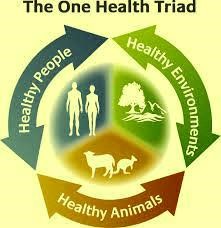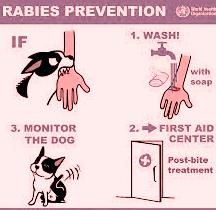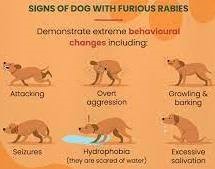Rabies: All for 1 , One health for One
Dr. Pallavi Khajuria, Assistant Professor, Department of Physiology and Biochemistry,
COVS, Rampura Phul, GADVASU
Introduction
It is said that the groundwork for all happiness is good health. Health is a precious asset that encompasses physical, mental, and social well-being. In today’s fast-paced world, maintaining good health can be challenging. However, an All-in-One Health Programme is emerging as a comprehensive and effective solution to address various facets of well-being. This essay explores the concept and importance of an All-in-One Health Programme, its components, and the benefits it offers to individuals and society. The “One Health” concept emphasizes the interconnectedness of human, animal, and environmental health and advocates for a collaborative, interdisciplinary approach to addressing complex health challenges. While there isn’t a single universal policy document for the One Health concept, various organizations, governments, and international bodies have developed guidelines and documents that promote the principles of One Health.
The All-in-One Health Programme: An Overview

The All-in-One Health Programme is a holistic approach to health that integrates various components of well-being into a comprehensive package. It recognizes that health is not limited to just physical fitness but extends to mental and social dimensions as well. This program aims to provide individuals with the tools and resources they need to achieve maintain optimal health in every aspect of their lives.
Components of the All-in-One Health Programme
- Physical Fitness: Physical health is a fundamental component of overall well-being. The programme includes regular exercise routines tailored to individual needs and abilities, along with guidelines for a balanced diet. This ensures that participants maintain a healthy weight, build strength, and reduce the risk of chronic diseases.
- Mental Health and Emotional Well-being: Mental health is equally vital. The programme offers strategies for managing stress, anxiety, and depression. It promotes mindfulness practices, counseling services, and mental health awareness to help individuals develop emotional resilience.
- Nutrition and Diet: A balanced diet is crucial for maintaining good health. The program me educates participants about the importance of nutrition, helps them make informed food choices, and provides access to dietary guidelines and meal planning resources.
- Preventive Healthcare: Regular check-ups and screenings are vital for early detection and prevention of diseases. The programme includes regular health assessments, vaccinations, and screenings to identify health issues before they become severe.
- Social Well-being: Social connections are essential for mental and emotional health. The programme encourages social interaction through support groups, community activities, and workshops to build strong and supportive networks.
- Health Education: Knowledge is power, and the programme provides comprehensive health education on topics like sexual health, substance abuse prevention, and healthy lifestyle choices. This empowers individuals to make informed decisions about their health.
- Work-Life Balance: Balancing work and personal life is critical for reducing stress and maintaining overall well-being. The programme promotes work-life balance strategies, time management, and stress-reduction techniques.
Benefits of the All-in-One Health Programme
- Improved Physical Health: Regular exercise and a balanced diet lead to better physical health, reduced obesity, and lower risk of chronic diseases such as heart disease and diabetes.
- Enhanced Mental Well-being: The program’s focus on mental health leads to reduced stress, anxiety, and depression. Participants learn how to cope with life’s challenges and build emotional resilience.
- Preventive Care: Regular check-ups and screenings catch health issues early, increasing the chances of successful treatment and reducing healthcare costs.
- Stronger Social Connections: Social activities and support groups foster a sense of belonging and reduce feelings of isolation, benefiting mental and emotional health.
- Healthier Lifestyle Choices: Education on healthy living empowers individuals to make informed decisions, leading to a healthier lifestyle.
- Increased Productivity: Work-life balance strategies improve work performance, reduce absenteeism, and enhance overall productivity.
- Cost Savings: Preventive care and healthier lifestyles result in reduced healthcare expenditures for both individuals and society.
Organizations linked with One health Programme
Many organizations and institutions around the world are actively involved in promoting and implementing the One Health approach, which emphasizes the interconnectedness of human, animal, and environmental health. These organizations work to address health challenges that span across these domains
- World Health Organization (WHO): The WHO plays a significant role in promoting the One Health approach and addressing global health issues. It collaborates with other international organizations and countries to enhance disease surveillance, control outbreaks, and improve public health.
- Food and Agriculture Organization (FAO): The FAO, a specialized agency of the United Nations, focuses on food security, agriculture, and the health of animals. It works to prevent and control zoonotic diseases and promote sustainable agriculture practices.
- World Organization for Animal Health (OIE): The OIE is dedicated to improving animal health and welfare worldwide. It sets international standards for the control of animal diseases and assists countries in managing and preventing disease outbreaks.
- Centers for Disease Control and Prevention (CDC): The CDC in the United States plays a crucial role in public health and disease control. It collaborates with various partners to monitor and respond to disease threats, including zoonotic diseases.
- National Institutes of Health (NIH): The NIH conducts research and supports research initiatives related to health, including studies on zoonotic diseases and the One Health approach.
- World Bank: The World Bank supports One Health initiatives related to health systems strengthening, disease prevention, and pandemic preparedness in developing countries.
- United Nations Environment Programme (UNEP): UNEP focuses on environmental conservation and sustainability. It is involved in projects that address the environmental aspects of One Health, such as climate change, habitat destruction, and pollution.
- EcoHealth Alliance: This nonprofit organization conducts research and builds capacity to prevent pandemics through a One Health approach, focusing on wildlife conservation, emerging infectious diseases, and human health.
- Wildlife Conservation Society (WCS): WCS works on the conservation of wildlife and wild places. It also conducts research on zoonotic diseases and their impacts on both wildlife and human populations.
- The One Health Commission: This organization is dedicated to promoting One Health awareness and collaboration. It facilitates networking and information sharing among professionals from various disciplines.
- One Health Initiative: This initiative is a global effort that promotes and supports the One Health approach through advocacy, education, and outreach. It aims to foster collaboration among human, animal, and environmental health professionals.
- University One Health Programs: Many universities worldwide have established One Health programs and research centers. These academic institutions conduct research, offer training, and educate the next generation of One Health professionals.
- These organizations, along with numerous other national and regional institutions, collaborate to address complex health challenges at the intersection of human, animal, and environmental health. Their efforts include disease surveillance, research, capacity building, and advocacy to promote the well-being of all living organisms on Earth.
Rabies: A Dreadful threat

Rabies is a zoonotic disease which can be transmitted from animals to humans. The primary reservoirs for the rabies virus are mammals, with domestic dogs being the most common source of human infection. However, wild animals such as bats, raccoons, skunks, and foxes can also carry the virus. Rabies is a 100% preventable disease, but still, tens of thousands of people die from it every year. Rabies is the 10th biggest cause of death due to infectious diseases worldwide. It is estimated that 2.5 billion people across 100 countries are at risk of contracting rabies.
Around 36% of these rabies related deaths occur in India every year with dog bites being responsible for 95-97% of these cases. The annual estimated number of dog bites in India is 17.4 million. As per the data it causes 18 000-20 000 deaths every year in India and 59,000 deaths worldwide.
About 30-60% of reported rabies cases and deaths in India occur in children under the age of 15 years as bites that occur in children often go unrecognized and unreported.
Transmission occurs primarily through the saliva of an infected animal entering the bloodstream of a susceptible host. This often happens through a bite, scratch, or open wound. Once the virus enters the nervous system, it travels to the brain, leading to neurological symptoms and, ultimately, death. The incubation period varies but is typically several weeks to months, during which time individuals can receive post-exposure prophylaxis (PEP) to prevent the onset of symptoms.
The progression of rabies is divided into two phases: the prodromal phase and the furious or paralytic phase. The prodromal phase includes symptoms such as fever, headache, and malaise. As the disease advances into the furious phase, behavioral changes become evident. Infected individuals may become agitated, disoriented, and display hyperactivity, eventually leading to seizures, hallucinations, and hydrophobia (fear of water).
The paralytic phase follows, marked by muscle weakness, paralysis, and coma. Once symptoms of rabies appear, the disease is virtually untreatable and almost invariably fatal. Hence, timely administration of PEP following a potential exposure is critical.
Prevention and Control
Education is key to rabies prevention. When people understand the risks and know how to protect themselves and their pets, we can save lives. Preventing rabies hinges on a combination of strategies, including:
- Vaccination: Vaccinating domestic dogs and other susceptible animals is a crucial component of rabies control. This reduces the risk of transmission to humans and establishes herd immunity.
- Post-Exposure Prophylaxis (PEP): Following a potential rabies exposure, immediate administration of PEP, consisting of rabies vaccine and rabies immune globulin, can effectively prevent the onset of symptoms if administered before the virus reaches the nervous system.
- Public Awareness: Educating communities about the risks of rabies, responsible pet ownership, and what to do in the event of an animal bite is essential in reducing human exposure.
- Stray Animal Control: Managing stray animal populations and promoting responsible pet ownership can minimize the risk of rabies transmission in urban areas.
- One Health Approach: Collaboration between human and animal health sectors, known as the One Health approach, is crucial for rabies control. It involves coordination among veterinarians, public health officials, and wildlife experts.

Global Efforts and Challenges
Rabies remains endemic in many parts of Asia and Africa, where access to healthcare and vaccines may be limited. Global initiatives, such as the World Health Organization’s “Zero by 30” campaign, aim to eliminate human rabies deaths by 2030 through mass dog vaccination and improved access to PEP.

Challenges in rabies control include limited resources in affected regions, lack of awareness, and cultural beliefs that sometimes hinder vaccination and reporting of rabies cases. International collaboration and sustained efforts are essential to overcome these challenges and achieve the goal of rabies elimination.
One Health program for rabies
Rabies is a reminder that nature can be beautiful and deadly, and our responsibility is to strike a balance that protects both humans and animals. A One Health program for rabies is a holistic approach that involves multiple sectors and disciplines working together to prevent and control rabies in both animals and humans. Rabies is a zoonotic disease, meaning it can be transmitted between animals and humans, and addressing it effectively requires a coordinated effort.
- Surveillance and Monitoring: Establish a robust surveillance system to monitor the prevalence of rabies in animals, especially in high-risk areas.
- Collaborate with veterinary and public health authorities to collect and share data on rabies cases in both animals and humans.
- Vaccination Campaigns: Implement mass vaccination programs for domestic animals, especially dogs, which are the primary source of rabies transmission to humans.
- Ensure that vaccines are readily available and affordable for pet owners and communities in rabies-endemic areas.
- Wildlife Management: Collaborate with wildlife conservation organizations and experts to monitor and manage rabies in wildlife populations, especially in regions where wildlife is a reservoir for the virus.
- Implement vaccination programs for wildlife in certain cases, where feasible.
- Education and Awareness: Conduct public awareness campaigns to educate communities about rabies transmission, the importance of vaccinating pets, and how to safely interact with animals.
- Promote responsible pet ownership and community-based approaches to control stray animal populations.
- Healthcare Infrastructure: Strengthen healthcare facilities, particularly in rural and underserved areas, to ensure that human rabies cases are diagnosed and treated promptly.
- Train healthcare professionals on rabies prevention, diagnosis, and treatment.
- Cross-Sectoral Collaboration: Foster collaboration between veterinary, public health, and wildlife agencies to share information and resources for a unified response.
- Engage local communities, NGOs, and international organizations to support rabies control efforts.
- Research and Innovation: Invest in research to develop more effective and affordable rabies vaccines for animals and humans.
- Explore innovative strategies for rabies control, such as oral vaccination programs for wildlife or new diagnostic tools.
- Legislation and Policy: Develop and enforce legislation and policies related to rabies control, including regulations for pet vaccination and responsible pet ownership.
- Emergency Response: Establish emergency response plans to swiftly address rabies outbreaks, including rapid deployment of vaccination teams and post-exposure prophylaxis for individuals exposed to rabies.
- Monitoring and Evaluation: Continuously assess the effectiveness of rabies control programs through data collection and analysis.
- Adjust strategies based on evolving epidemiological trends.
- International Collaboration: Collaborate with neighboring countries to address cross-border rabies transmission and share best practices.
Implementing a One Health program for rabies requires commitment, resources, and cooperation among various stakeholders. The goal is to eliminate human rabies deaths by preventing the transmission of the virus from animals to humans. This approach not only saves lives but also reduces the economic and social burden of rabies in affected communities.
Summary
Rabies is a deadly disease that has plagued humanity for centuries. While significant progress has been made in controlling rabies through vaccination and awareness programs, it continues to be a public health threat in many parts of the world. A coordinated global effort, guided by the One Health approach, is necessary to eliminate human rabies deaths and reduce the suffering caused by this ancient scourge. With continued dedication and resources, it is possible to consign rabies to the annals of history and prevent needless deaths from this terrifying disease. Overall, the emergence of all-in-one health programs reflects a shift in healthcare paradigms toward a more holistic and patient-centered approach. It involves continuous research into new treatments, therapies, and technologies is essential for improving disease control. It also deals with preparedness for disease outbreaks and emergencies is also a key aspect. Robust emergency response plans and stockpiles of necessary medical supplies are essential for disease control. Encouraging innovation in healthcare is part of a comprehensive approach. These programs aim to empower individuals to take control of their health and well-being by addressing all relevant aspects of their lives. By integrating various components into a comprehensive package, it empowers individuals to take charge of their health and lead fulfilling lives. This program not only benefits individuals by improving their quality of life but also contributes to a healthier and more productive society. It is a beacon of hope for a future where health is truly comprehensive and all-encompassing. The Veterinary profession is an integral part of the One Health framework, contributing expertise in animal health, zoonotic disease control, food safety, and environmental health. Collaborative efforts between veterinarians, medical professionals, public health experts, and environmental scientists are essential to address the complex health challenges that impact humans, animals, and the planet.

